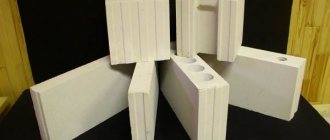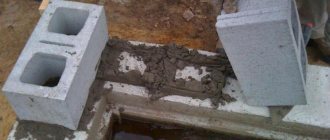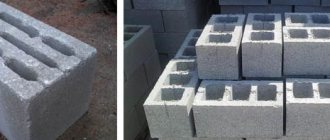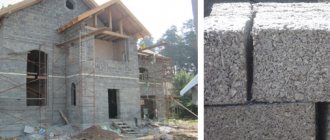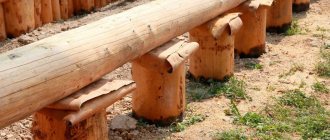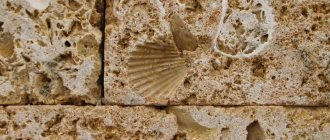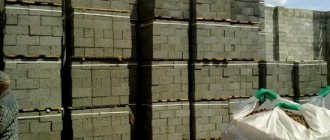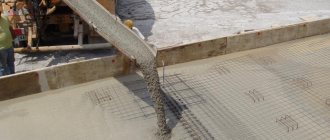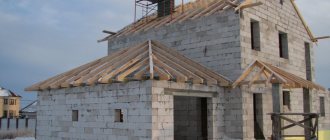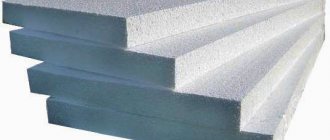Cinder block is a wall stone made from solid fuel formations obtained as a result of combustion. Expanded clay, crushed stone, brick fragments, and sawdust are used in production. The technology consists of preparing a solution with the addition of clay and water and compacting it using vibration, after which the mixture is loaded into molds until complete hardening, which lasts about a month.
Calculation formula
When building a house from wall stone, the question often arises of how to correctly calculate how much cinder block is in 1 cubic meter. An accurate calculation will help determine the amount of material and minimize construction costs. Therefore, engineers use the existing formula:
1. The easiest way to start the calculation is with the standard size of a cinder block. This is 390x188x190 mm - length (L), height (H) and width (B), the volume is marked with the letter V.
2. To find out the required value, you will need to multiply three parameters. The result will be 390x190x188=13930 cm3.
3. The volume of a cubic meter unit is 1,000,000 cm3. Now you can calculate how many blocks there are in one cube by dividing the total figure by the value of a unit of stone: 1,000,000: 13930 = 71.78, round up and get 72 pieces.
It is necessary to take into account that the length of the cinder block is not a multiple of the same parameter of the cube, so 20% less material will fit. When making calculations, some experts add the distance between units during laying, this is approximately 5 mm per side, excluding the height, as shown by the following formula: (L+5)xHx(B+5), which in numbers will be (390+5) x188x(190+5)=395x188x195=14480700 mm or 0.0144807. As a result, in one cubic meter there are 1,000,000: 0.0144807 = 70 pieces.
Varieties
Since cinder blocks are used for different tasks, it is important to consider other dimensions. With the same input data for the width, length and height of the semi-blocks, the initial void figure changes; it varies from 28 to 40%, which affects strength, heat and sound insulation. Therefore, when making calculations you need to know certain nuances:
1. The weight of the wall stone is noted to be between 25 and 28 kg. In production, cinder blocks with dimensions of 400x200x200 and 395x195x195 are produced.
2. Hollow materials are purchased for arranging load-bearing structures. Their weight varies between 18-23 kg.
3. For interior partitions, a half-block is suitable, which has a voidness parameter taken into account in the calculation. Applying the basic formula, you can understand that with an indicator of 30% you will need 92 pieces, and for 40% - 99, provided that standard sizes are used. The weight of this stone is 10-13 kg.
4. The strength grade also plays a role. For the construction of walls and interior work, the M35-M75 block is used, and the construction of the foundation involves M125-M200.
5. The integrity of the material is of great importance, so when choosing, you need to check the geometry and the absence of defects. Experts recommend comparing several pieces to make sure there is a slight deviation from the norm. It is better to make a one-time purchase from one batch, this will ensure an acceptable discrepancy.
Having found out how many cinder blocks are contained in one cube, you can calculate the dimensions of the wall. Having established the thickness of the seam, count the number of rows, then the length and height of the future structure. Thus, using formulas for all stages of construction, the water data of the foundation and square meters of masonry are determined, and then they begin to purchase materials. Upon purchase, 15% is added to all results obtained. The need is explained by the fact that the cinder block is damaged during transportation and unloading, this will affect further work. Wall stone is often sold in pallets that hold 60 units. Since the quantity is slightly short of the figure obtained in the calculation, the required stock should be calculated.
Economical construction, such as the construction of low-rise buildings made of cinder blocks, requires an accurate calculation of the required amount of this building material, including a clear understanding of the answer to the question: how many cinder blocks are there in a cube? This is especially useful if the volume of all walls is measured in cubic meters, and you need to calculate how much cinder block you will need for the planned construction.
Calculation of the amount of cinder block per square meter of wall
According to the requirements of GOST 6133, a standard cinder block is made with dimensions of 390x190x188 mm and has a volume of 0.014 sq. m. Based on the known size of the block, you can accurately calculate the volume of required building materials and the amount of cinder block. To calculate the approximate number of blocks in 1 sq. m, use simple mathematical techniques.
Option 1 - a wall as thick as half a block or 190 mm
Wall as thick as half a block
Knowing that the height of the cinder block is 188 mm and the length is 390 mm, its lateral area is calculated (after converting all values to the SI system):
S side surface =0.188*0.39=0.073 sq. m.
Now, knowing the area of one block, you can calculate how many blocks will be needed to build 1 square meter. m. walls.
N blocks in 1m2 = 1/0.073 = 13.64 pcs.
The resulting value is slightly larger than the actual value, since we did not take into account the thickness of the mortar joint.
If we take into account the seam thickness of 8–10 mm, then in reality we will need not 13.64 pieces, but exactly 13 pieces.
Option 2 - a wall one block or 390mm thick
A wall as thick as a block
The calculation algorithm is the same.
S side surface =0.188*0.19=0.036 sq. m.
N blocks in 1m2 = 1/0.036 = 27.99 pcs.
And taking into account the mortar joint, we will need 26 pieces of whole blocks.
This is the initial stage of calculations. To find out a more accurate quantity and consumption of building materials for the project, you need an estimate for construction work, that is, you need to calculate how many cinder blocks may be needed to build the entire house.
The total scope of work determines the total cost of the object, which consists of:
- 30% - foundation, concrete mortar (adding cement, sand, water, slag aggregates), reinforcement frame, excavation work.
- 45–50% - walls of the facility, including load-bearing structures and lintels.
- 20–25% - roofing.
Let's assume that the entire volume of construction work will be based on the use of cinder blocks - the construction of a foundation, walls and partitions. To calculate the number of products pressing on the foundation, you need to know the weight of the load-bearing wall, which depends on the type of cinder blocks used. These can be either solid or slotted blocks. Their weight varies from 11 to 28 kg.
Manufacturing
The process of making cinder blocks is quite simple and is divided into the following operations:
- Preparation of a solution, which is a semi-dry mixture in a certain proportion of cement, sand, aggregate and water.
- Placing the solution in metal molds mounted on a vibrating table.
- Vibration with the simultaneous use of a press, which additionally compacts the solution.
- Excerpt in forms. Initial grip. It is good if there are special steaming chambers that create an environment in which high temperature accelerates the chemical reactions of cement setting, and hot steam does not allow the product to dry out.
- Dismantling of molds and storage. When using steam, products can be shipped immediately after production. Without steaming, the blocks are kept in molds for 5...7 days, after disassembling them they are sent to a warehouse and kept for another 20 days, after which the products can be considered ready and can be put up for sale or used to build a house.
Calculation of the amount of cinder block per house
As a basis for calculations we take:
- Standard unit dimensions are 390x190x188 mm.
- The mass of the block with two voids is 17 kg.
- The dimensions of a one-story house are 8x8x3 m (Length x Width x Height).
Counting by rows of masonry - how many units of wall stone fit in one row. To do this, you need to know the dimensions of the block and the dimensions of the house. Then we will calculate how many cinder blocks per 1 sq. m. will be needed to build a supporting box.
- To do this, calculate the perimeter of the house: P house =8*4=32 m.
- To find out the number of units of products in one row, you need to divide the perimeter of the house by the length of the block: N pieces in 1 row = 32/0.39 = 82.05 pieces.
- Next, we calculate the total number of rows. The height of the walls is divided by the height of the building block: N rows = 3/0.190 = 15.78 rows.
- We find out the total number of blocks per house by multiplying: N total = N pieces in 1 row * N rows = 82 * 16 = 1312 pieces.
Based on the results, you can calculate the weight of the building that will put pressure on the foundation: weight 1 pc. - 17 kg multiplied by the total number of units, we get 22304 kg. Since the preliminary calculation was carried out without taking into account window and door openings, they should be subtracted in the process of a more accurate calculation, just as their weight should be subtracted from the total weight of the load on the foundation.
Since cinder blocks are usually stored on pallets, it is recommended to calculate the required number of pallets before purchasing them. One pallet holds 60 units of products. Therefore, based on the example above, a house measuring 8 x 8 x 3 m would require approximately 20 pallets.
For the foundation, the most optimal material will be blast furnace slag; for the walls, you can use any filler - ash slag, brick or stone rubble, crushed stone or gravel. To obtain a solid product, it will take 0.011 m 3 of working solution to produce one unit of building stone. That is, from a bag of cement you will get 36 units of standard size with a bag weight of 50 kg.
The more accurately the equipment is configured, the less mortar will be consumed for laying blocks in rows, and the more products will be produced from one bag of cement.
Calculation of the number of cinder blocks per 1 m2 of wall
Cinder block is a building material for the construction of foundations, walls and partitions, buildings and industrial facilities.
It is made by pressing a slag concrete solution prepared from: cement, sand, volcanic ash, granite crushed stone, broken glass or brick, crushed stone, crushed concrete, fine expanded clay, river gravel, slag.
To calculate the required number of cinder block units per 1m2, simple calculations are used.
According to the requirements of GOST 6133, a standard cinder block is made with dimensions of 390x190x188 mm and has a volume of 0.014 sq. m. Based on the known size of the block, you can accurately calculate the volume of required building materials and the amount of cinder block. To calculate the approximate number of blocks in 1 sq. m, use simple mathematical techniques.
Option 1 - a wall as thick as half a block or 190 mm
Wall as thick as half a block
Knowing that the height of the cinder block is 188 mm and the length is 390 mm, its lateral area is calculated (after converting all values to the SI system):
S side surface =0.188*0.39=0.073 sq.
History of the material
Residential and public buildings, factory workshops, fences and enclosures were erected from cinder blocks. Many of these buildings have survived to this day in very satisfactory condition. Previously, cinder blocks were made from concrete, where ash was used as a filler. It could be blast furnace slag - waste from the metallurgical industry, or coal residues formed after its combustion during the operation of boiler houses, power plants, combined heat and power plants (CHP).
The use of waste to make building stone also solved the problem of their disposal. Today, despite the name, the content of ash in a concrete solution is not considered mandatory. Consists of granite crushed stone, expanded clay, broken glass, broken brick and cement mortar.
Number of cinder blocks per 1 m2 of masonry
Now, knowing the area of one block, you can calculate how many blocks will be needed to build 1 square meter. m. walls.
N blocks in 1m2 = 1/0.073 = 13.64 pcs.
The resulting value is slightly larger than the actual value, since we did not take into account the thickness of the mortar joint.
If we take into account the seam thickness of 8–10 mm, then in reality we will need not 13.64 pieces, but exactly 13 pieces.
Option 2 - a wall one block or 390mm thick
A wall as thick as a block
The calculation algorithm is the same.
S side surface =0.188*0.19=0.036 sq. m.
N blocks in 1m2 = 1/0.036 = 27.99 pcs.
And taking into account the mortar joint, we will need 26 pieces of whole blocks.
This is the initial stage of calculations. To find out a more accurate quantity and consumption of building materials for the project, you need an estimate for construction work, that is, you need to calculate how many cinder blocks may be needed to build the entire house.
The total scope of work determines the total cost of the object, which consists of:
- 30% - foundation, concrete mortar (adding cement, sand, water, slag aggregates), reinforcement frame, excavation work.
- 45–50% - walls of the facility, including load-bearing structures and lintels.
- 20–25% - roofing.
Let's assume that the entire volume of construction work will be based on the use of cinder blocks - the construction of a foundation, walls and partitions. To calculate the number of products pressing on the foundation, you need to know the weight of the load-bearing wall, which depends on the type of cinder blocks used. These can be either solid or slotted blocks. Their weight varies from 11 to 28 kg.
Cement consumption for laying one cubic meter
When constructing brick buildings and structures, many use the standard ratio of cement and sand: 1:4
respectively. However, the cinder block has a larger area, which makes the usual ratio of the components of the cement-sand mixture unacceptable. Therefore, here you can be guided by the following scheme:
- Cement - 8 bags.
Sand - 1 bag.
Water - in the required quantity for convenient work with the solution.
If we talk about how much solution is required to lay one cubic meter of cinder block, then we can use the figures 210-250 liters
. The amount of material may vary depending on the brand of cement used.
Calculation of the amount of cinder block per house
As a basis for calculations we take:
- Standard unit dimensions are 390x190x188 mm.
- The mass of the block with two voids is 17 kg.
- The dimensions of a one-story house are 8x8x3 m (Length x Width x Height).
Counting by rows of masonry - how many units of wall stone fit in one row. To do this, you need to know the dimensions of the block and the dimensions of the house. Then we will calculate how many cinder blocks per 1 sq. m. will be needed to build a supporting box.
- To do this, calculate the perimeter of the house: P house =8*4=32 m.
- To find out the number of units of products in one row, you need to divide the perimeter of the house by the length of the block: N pieces in 1 row = 32/0.39 = 82.05 pieces.
- Next, we calculate the total number of rows. The height of the walls is divided by the height of the building block: N rows = 3/0.190 = 15.78 rows.
- We find out the total number of blocks per house by multiplying: N total = N pieces in 1 row * N rows = 82 * 16 = 1312 pieces.
Based on the results, you can calculate the weight of the building that will put pressure on the foundation: weight 1 pc. - 17 kg multiplied by the total number of units, we get 22304 kg. Since the preliminary calculation was carried out without taking into account window and door openings, they should be subtracted in the process of a more accurate calculation, just as their weight should be subtracted from the total weight of the load on the foundation.
Since cinder blocks are usually stored on pallets, it is recommended to calculate the required number of pallets before purchasing them. One pallet holds 60 units of products. Therefore, based on the example above, a house measuring 8 x 8 x 3 m would require approximately 20 pallets.
For the foundation, the most optimal material will be blast furnace slag; for the walls, you can use any filler - ash slag, brick or stone rubble, crushed stone or gravel. To obtain a solid product, it will take 0.011 m 3 of working solution to produce one unit of building stone. That is, from a bag of cement you will get 36 units of standard size with a bag weight of 50 kg.
The more accurately the equipment is configured, the less mortar will be consumed for laying blocks in rows, and the more products will be produced from one bag of cement.
https://kamedom.ru
How many cinder blocks per square meter
If you decide to lay out walls from cinder blocks and have already measured the area of each wall (by the way, we calculate the area using the formula - we multiply the height of the wall by the width), it’s time to calculate how many cinder blocks are in a square meter
to find out the required quantity for the entire construction.
A standard cinder block measures 39cmX19cmX19cm. Let's say the width of the future wall will be equal to 19 cm (when cinder blocks are laid out along the wall), we need to calculate the lateral area of the cinder block using the same formula, multiplying its width by length, it turns out 39x19 = 741 cm2.
To calculate how many cinder blocks per square meter we have 10,000 cm2 (1m2): 741 cm2, we get 13.49 pieces of cinder blocks. Knowing the dimensions of the block used, you can always calculate how many cinder blocks fit in 1 m2.
Dimensions of cinder blocks: composition and proportions of material
Cinder block is a type of building stone that is quite widely used in the construction of modern buildings. It is used to create load-bearing structures, interior partitions and lightweight foundations. Such blocks are used in both private and commercial buildings.
Cinder blocks can be made from various materials
It should be noted that a variety of raw materials are used for the solution from which cinder blocks are formed, so the composition of cinder blocks does not have a strict recipe. Most often, a sand-cement mixture is used as a base, which is subject to vibrocompression in special forms. Various fillers and components are used as additional additives, which increase the quality, strength and frost resistance of finished premises.
What is cinder block made from? To create this building stone, a mixture of the following components is most often used:
- expanded clay stone;
- finely crushed bricks;
- sawdust;
- metal smelting waste - slag;
- perlite;
- gypsum;
- sand.
According to production technology, the following proportion for the mixture is usually used: 9:1 (nine parts of slag and one part of cement). Water for the solution is taken in the ratio of half of the total volume of all components. It should be noted that this is a standard technology, which may differ from one manufacturer to another depending on the components used.
It is important! You need to know that cinder block walls should not exceed the third floor in height. For the construction of taller buildings, it is better to use combined masonry.
Most often, a sand-cement mixture is used to produce blocks.
Calculation of the number of cinder blocks per 1 m2 of wall
If the result obtained is multiplied by the total area, you will get the total number of cinder blocks for the entire construction. Don’t forget about the masonry joints; due to them, you will need a little less blocks.
Affordable price, good performance characteristics, convenient dimensions for accelerated laying - these are the main advantages of such a building material as cinder block. It has found wide application in the construction of permanent residential buildings, garages, and outbuildings.
Cinder blocks are produced from a special concrete mixture and slag, which is used as various construction and other waste.
They lay out the foundation, partitions, and walls. The main advantage of the material is that it can be purchased ready-made or made at home.
Regardless of whether they use their own or factory-produced blocks, the developer needs to clearly know how much material is required for one square meter of masonry.
Characteristics of building stone
Cinder block, prepared in full compliance with the technological process, belongs to the category of lightweight concrete. Therefore, the material has the following characteristics:
- Strength indicator - varies between 25-150 kg/cm2.
Density (average value) - 1050-1200 kg/m3.
Frost resistance - up to 25 cycles.
Moisture absorption - up to 75%.
Fire resistance - up to 800 degrees Celsius.
Thermal conductivity table
It is worth noting that walls made from one cinder block should not exceed 3 floors. For taller buildings, combined masonry is used. Please note that cinder block, like any building stone, has zero shrinkage - this is an ideal indicator in construction.
Seam thickness
It has a direct effect on the consumption of cinder block, but towards a decrease. This indicator is not always taken into account, especially when savings are not critical. This approach is only suitable for small buildings. The amount of extra block, if seams are not taken into account, can be quite significant for large buildings.
The thickness of the seams depends on the material:
- when glue is used, the seam is 2-3 mm;
- if a solution is used, the seams are made 5-10 mm.
The adhesive composition is not widely used, so the calculation takes into account an indicator from 0.5 to 1 cm. However, it is not taken into account in the formula, but is only subtracted from the resulting value, based on the number of rows.
An example of calculating the number of cinder blocks
If a standard cinder block (390x190x188) is used, the calculation is as follows:
- 190 mm wall or block floor.
The width and length are converted into centimeters, obtaining the values 0.188 and 0.39, then the lateral area is calculated, that is, S = 0.188 * 0.39 = 0.073. Since the dimensions were converted to centimeters, the resulting value is already calculated in square centimeters, which allows us to proceed to the final calculation, that is, finding N = 1/0.073 = 13.64 blocks. If we take into account the seams, it turns out that when laying a block in the floor, about 13 pieces of cinder block are required for each square centimeter. - The wall is 390 mm or one block. The calculation algorithm is similar to the previous version, but the values are certainly different.
In other words, S = 0.188 * 0.19 = 0.036, that is, the lateral area turns out to be completely different from the first option, N = 1/0.036 = 27.77 or approximately 27 pieces, if we take into account the thickness of the masonry mortar. Therefore, the wider the wall, the greater the number of blocks to be purchased.
These calculations can be applied to absolutely any structure being built using cinder block.
Why calculate the amount of cinder block in one square meter?
This initial stage of calculation is necessary to determine the exact amount of material required for the construction of a particular building. Thus, knowing the consumption per 1 sq. m., it is not difficult to calculate the total costs of the material. If a garage is being built with masonry in the floor of the block, the wall area of which is 51 square meters, this means that 663 cinder blocks need to be purchased. This amount will double if the building is built with walls 390 mm thick. In addition, you should always remember that the material should be purchased with a small reserve, taking into account possible defects or damage to the blocks directly during laying.
When buying 1 cubic meter of cinder blocks, few people think about how many cinder blocks there are in this meter. Many may think: “Why do we need to know this, what is this for?” In fact, the value of the quantity of material is the same value as the calculations of architects and engineers before the construction of a new facility. Knowing the exact amount of materials and accurate calculations by engineers, it is possible to calculate with mathematical accuracy the number of cinder blocks required for construction, minimizing unnecessary costs for the owner of the facility under construction.
How to count the number of cinder blocks in 1 cube?
To correctly calculate how many cinder blocks are in a cube, you need to know the dimensions of the material itself. The easiest way is to calculate how many cinder blocks are in 1 cubic meter. m., according to the standard size of the building material. And this size is equal to:
- 390 mm in length;
- 188 mm in height;
- 190 mm wide;
- Desert level at 28%.
This is the most common size of cinder blocks used in the construction of modern facilities. Next, to count cinder blocks, you will need a special formula for determining the volume of 1 unit of standard size cinder block: V (volume) = L(length) × B(width) × H(height).
Volume 1 cubic. m is a value equal to 1,000,000 cubic meters. cm. Now, you need to calculate the volume of one cinder block 390 × 188 × 190 = 13930 cm3, 13930 cm3 - this is the volume of one cinder block. Now, it will not be difficult to calculate the number of cinder blocks per cubic meter. To do this, you need to divide the total volume by the volume of one unit of cinder block: 1000000/13930 = 71 units.
Thus, standard cinder blocks of 1 cubic meter. m. - 71 units, and when starting construction, it is necessary to build on this number of units of building material.
Do not forget that these are only calculations of the standard and most popular size of cinder block; in the case of other sizes of material, the final result will be different.
Popular (in addition to the standard) sizes of cinder blocks (l/h/w. in mm):
- 590x90x188 - partition cinder block;
- 410×215×190 - one-piece construction cinder block of increased size;
- 390x90x188 - longitudinal cinder block slab.
Types and standard sizes of slag concrete blocks
In most cases, cinder blocks of all types are manufactured in accordance with GOST standards, and therefore have strictly defined parameters. In particular, the following dimensions are considered the generally accepted standard:
- Length - 390 mm
Width - 190 mm
Height - 188 mm
The standard is due to the fact that one stone replaces 4 bricks in volume
, which simplifies calculations during construction.
However, the following sizes may be found on the market: 400*200*200
and
395*195*195
.
This stone is often used in the construction of industrial facilities. When constructing interior partitions, products with the following dimensions are used: 390*120*188
.
Why do you need to count the number of cinder blocks?
Having correctly calculated how many cinder blocks there are in a cube, you can move on to the economic part of construction, and calculate how many cubes of material will be required for the construction of the object under construction.
The specified formula for calculating the amount of building material in one cube is used for a wide variety of materials sold in cubic volumes. The formula allows you to calculate the required amount of materials for construction, accurate to one.
Considering the rather high cost of modern building materials, such a careful calculation of the number of cinder blocks required for construction is a mandatory and very important procedure that allows you to save the owner’s finances.
When designing and building houses and other structures, you almost constantly have to deal with various measurements and quantities. It is necessary to calculate the surface area, the perimeter of the walls and the volume of foundation pouring.
However, the question of how much cinder block in 1 cubic meter is usually allocated separately, since it is associated with different features of this material.
System of measurements and calculations when choosing building materials
First of all, it should be noted that basic knowledge of subjects such as mathematics and geometry will help answer any question related to measurements and quantities. There are special formulas and calculation methods for this.
However, when asking the question of how many cinder blocks are in 1 cube, it is worth remembering that a unit of this material can have completely different sizes, which depend on its manufacturer.
How much material is in a cube when purchasing
- Before ordering a cinder block from the manufacturer, you need to clarify the dimensions of one unit of the product
. In the standard version they look like 40 cm x 20 cm x 20 cm, in length / width / height ratios. - Based on this, we can conclude that one block occupies a volume of 0.016 cubic meters. This is calculated by multiplying the length, height and width by each other, converting all values into meters.
- (0,4 * 0,2 * 0,2 = 0,016)
- Thus, in order to find out how much cinder block is in a cube, you need to divide 1 by 0.016.
- The result is a value equal to 62.5, but taking into account the fact that half of the product can not be counted, it comes out to 62.
However, it is worth noting that during transportation and installation of this material, its integrity is often violated. This is due to the fact that the cinder block is quite fragile and unstable to moisture. That is why the installation instructions recommend ordering cinder blocks with a 10% reserve.
Advice! For greater confidence or to avoid misunderstandings, it is best to ask the manufacturer or supplier how many units of its products are in one cubic meter.
How many meters of wall
Having decided how much a cube of cinder block costs and how many units there are in a given volume, you can determine the length and height of the future wall.
- To make such calculations, you need to know the height of the structure.
- As a guide, you can take the most optimal size of 2.5 meters.
- Next, approximately determining the thickness of the seam to be 1.5 cm.
- After this, we divide the wall height of 2.5 m by the block height of 0.2 m and in the end we get 7. This number will be equal to the number of rows.
- Then we divide the amount of cinder block in the cube by 7 and get the number 8.8, which will be equal to the number of units of material in the row. In this case, it is worth rounding this value to 8.
- Next, we multiply the quantity by the length of the material, and we get a wall with dimensions of 3.2 x 2.5 meters.
- (8 * 0,4 = 3.2)
- However, if you take into account the thickness of the seam, you can build a structure measuring 2.5 by 3.5.
However, it is worth noting that such calculations are very approximate.
Advice! To make more accurate and complex calculations, it is best to use a special program that will greatly simplify the entire process.
Brick calculator
To simplify all construction calculations, a special program was invented called a brickwork calculator. Using it, you will not need to make calculations yourself, for which you just need to enter all the initial data, which will be processed and the corresponding result will be given.
The main feature of such a program is that it not only calculates the volume of masonry, but also takes into account the presence of windows and doorways. It can also work with any type of material, from ordinary bricks to blocks. In this case, such a calculator can take the thickness of the seams as the primary data, and display the amount of mortar as a result.
It is worth noting that the price of such a program is usually low, although there are also quite expensive versions installed on portable devices. However, on our website you can download it absolutely free.
Conclusion
In the video presented in this article you will find useful information on this topic. In addition, based on the above calculations, we can conclude that during the construction and design of buildings one has to deal with various types of calculations, and special programs called brickwork calculators can simplify them.
To find out how many cinder blocks are in a cube, just perform a simple calculation. It is carried out before the start of work, when products are purchased individually or by cubic meters. Typically, cinder blocks are sold on pallets, the number and volume of which depends on the type of product and the weight of one unit of goods.
As part of a project for the construction of any facility, an estimate is developed that takes into account the volume of work. Brick and cinder block masonry in this case are measured in cubic meters. The number given in the document is not always an integer, which causes certain difficulties in calculation. Then it is necessary to determine the number of slag concrete blocks not only in 1m3, but also in 1m2, because Exterior and interior finishing is characterized by a different unit of measurement.
If the project is being developed by a construction company, you can turn to it for help. The specialists themselves will calculate how much material is needed and advise which store is best to contact. If you develop a construction project yourself, you will have to manually calculate the amount of required building materials. A construction estimate is most often a custom document drawn up by a specially trained person—an estimator. The estimate contains information not only about the scope of work, but also its cost. The latter is not the only correct one, because depends on many factors. In this case, when calculating cinder block masonry, the quality of cement introduced into the cement-sand mortar, the cost of additives, the presence of reinforcement, etc. are taken into account.
To calculate the amount of cinder block in 1 m³, you need to take into account several features:
- There are several types of slag concrete block, which differ in purpose and size, as a result of which its quantity varies in 1 m² and 1 m³. When using different types of products (facing, standard, partition) you will need different amounts of material.
- A slag concrete product consists of blast furnace slag, crushed cement, granulated screenings or crushed stone, and cement is used as a binder. The composition does not affect the amount of product in 1 cubic meter, but changes its mass. This should be taken into account when transporting the calculated amount of material to the work site. Also an important factor is the presence of voids in the product.
- Cinder concrete blocks can be made at home, in which case the dimensions may differ slightly from the dimensions of industrially produced products. Here it is necessary to take into account the average lengths of the sides of the building material in order to determine how many cinder blocks are in the cube.
- The dimensions of the standard block are 390x190x190 mm. When calculating, these dimensions increase slightly and are taken as 400x200x200 mm, this is due to the presence of a solution with a thickness of at least 10 mm between the blocks.
Sanitary aspect. Is it harmful to health?
It is reliably known that cinder blocks are made from waste from smelting production; therefore, there is a possibility that the composition contains components harmful to health in quantities exceeding the norm. In addition, the material absorbs moisture well, releasing toxic fumes that can harm human health.
Obviously, the concentration of harmful impurities is determined by the type of slag that was used in the formation of the building material.
The best and cleanest waste is considered to be the waste obtained from the smelting of iron ore in a blast furnace, but everything is not so simple... The problem is that even pure (without harmful impurities) slag is phonite, it has a natural radiation background received “inherited” from iron ore and releases radioactive particles.
What should be done in order to minimize the risks associated with the use of materials based on metallurgical waste in construction:
- Certificate
. The situation with them is complicated and you can get the coveted piece of paper from the SES using far from the most harmless material. But you still need to require a certificate, especially when purchasing from bulletin boards where they often offer building stone without any documents at all.
It is believed that in order to completely eliminate possible risks, the material must lie in the open air for 36 months.
. Therefore, it makes sense to be interested in the date of manufacture, which is again indicated in the certificate, or to condition the cinder block yourself.
In addition, the walls are covered with waterproofing and lined with brick. Indoors also includes finishing of the walls.
Analyzes in construction research institutes
or laboratories. An ideal option that will guide you regarding a specific batch of material. It is enough to break off a small sample - there is no need to drag the whole brick.
Cinder blocks can be sold individually or by cubic meters. For ease of transportation, loading and unloading, pallets are used. Before starting construction work, it is necessary to calculate the amount of material, so it is important to know how many cinder blocks are in the pallet. A pallet is a wooden structure, that is, a stand on which cinder blocks are placed. This design is strong and durable, which allows you to transport various types of materials. One cubic meter of cinder blocks can be placed on a standard type pallet. To find out how many cinder blocks are in a pallet, you need to calculate their number in one cubic meter.
- First you need to calculate the volume of each unit separately. Since the same type of cinder block is placed on a pallet, it is enough to multiply the length by the width and the depth of one block.
- After this, the amount of material per cubic meter is calculated; for this, the volume of all material located on the stand is divided by the volume of one unit.
- To make it easier to calculate quantities, dimensions are converted to meters.
Cinder blocks can have different sizes, their number in the pallet depends on this.
- dimensions 390*190*190, 71 pieces in a pallet;
- dimensions 390*190*94, 194*190*190, 142 pieces in a pallet;
- dimensions 194*190*94, 96*190*190, 333 pieces in a pallet;
- dimensions 290*190*190, 100 pieces in a pallet;
- dimensions 290*190*190, 200 pieces in a pallet;
- dimensions 96*94*190, 588 pieces in a pallet.
Such calculations apply to both hollow materials and solid blocks. The above calculations are considered inaccurate, since it is very difficult to ideally place the blocks on the stand without a gap. All calculations depend only on the block size. The most popular are the standard sizes, that is, 390*190*190; if there are gaps between the material, then its capacity in the pallet will be 60 pieces.
How to calculate the number of blocks in 1 m³?
Cinder block calculations are made using simple formulas. First you need to calculate the volume of one product (V) by measuring its length (L), width (W), height (H) and multiplying these values:
V=L*W*H (cubic meter)
It is better to substitute dimensions in the formula in meters; this will not lead to errors in further calculations.
To find out how many cinder blocks (N) there are per 1 m³, you need to divide this number by the resulting volume:
N=1/V (pieces)
These formulas are universal; they will allow you to accurately calculate the amount of cinder block in any volume accepted on the basis of the estimate. With their help, you can also determine the amount of material to build a cinder block house, an extension to it and other objects.
Calculation example
How many standard cinder blocks are in one cube?
Let's determine the volume: V= 0.4*0.2*0.2=0.016 cubic meters.
Let's determine how many cinder blocks are in one cube: N=1/0.016=62.5 pieces.
That is, one m³ contains 62.5 pieces of slag concrete block. The estimated amount of cinder block per house, measured in cubic meters, must be multiplied by the number of products per 1 m³. As a result, we get the total amount of material needed for construction.
When calculating, it is worth paying attention that the resulting amount must be increased by 10-15%. This will eliminate the shortage of building materials in case of detection of defects, damage to blocks during construction, etc.
What to consider when purchasing
How to calculate a cinder block is a natural question that will arise when building a house from a cinder block. You always need to know exactly how many stones (in pieces) you will need for the job. There may be different ways to calculate the amount of cinder block, based on the number of stones in one cubic meter of masonry, the area of the wall, or calculation by row of wall.
Volume
It is known that one cubic meter of cinder block masonry with a mortar thickness of 10 mm contains 62.5 stones. Measuring the volume of a wall, for example, let it be a wall 0.4 m thick, 12 m long and 3 m high, we get: 0.4 x 12 x 3 = 14.4 m3.
Multiplying this value by 62.5 we get 62.5 x 14.4 = 900 pcs. Information about the sizes and thicknesses of walls and partitions should be contained in the design documentation for the house on its plans and sections. By calculating their volume in cubic meters and multiplying it by the number of stones in one square meter, we get the total number of cinder blocks.
Square
How many cinder blocks are there in 1 m2 of masonry? To lay one square meter of wall area, 2.5 x 5 = 12.5 stones are required.
If the wall thickness is:
- 0.5 stone (0.2 m) – 12.5 pcs.;
- 1 stone (0.4 m) – 25 pcs.;
- 1.5 stones (0.6 m) – 37.5 pcs.;
- 2 stones (0.8 m) – 50 pcs.
Taking data from the project on the areas and thicknesses of all external and internal walls, you can calculate the total amount of cinder block required for construction.
When calculating, it is better not to take into account window, door and other technological openings, since cinder block masonry is accompanied by a larger amount of waste than brick masonry, which will thus be compensated for.
Services
How to use an online cinder block calculator for building a house. To calculate the number and cost of cinder concrete blocks, you can also use any cinder block calculator, which are widely available online. To do this, you need to fill out the appropriate fields in a specially designed form, which contain:
- cinder block dimensions (L x W x H)
- the total length of the walls (Important: do not forget that external and internal walls can have different thicknesses, so calculations for them must be performed separately)
- wall height
- thickness of masonry mortar
Additionally, you can find out the total weight and cost by including data for 1 stone in the calculation of a cinder block per house. The online calculator also allows such calculations.
Helpful information:
Typically, cinder blocks are produced in special wooden pallets. How many cinder blocks are in one pallet? Most often their quantity corresponds to one cubic meter. The number of tightly packed slag concrete stones on one pallet is 71 pcs. (Not to be confused with the number of stones in 1 m3 of masonry on mortar).
How many cinder blocks are there in 1 m²?
- Calculate the base area of the cinder block: S=L*W (square meter).
- Determine quantity: n=1/S (pieces).
Using these formulas, you can determine how many cinder blocks in 1 standard pallet are on the same level. During transportation, the blocks are placed close to each other, this preserves their integrity, eliminates mechanical damage and reduces the dimensions of the cargo. However, pallets are not manufactured in 1 m² size, they are standard and have a size of 1.2 x 0.95 m.
